
Gilles Bertaux on How He Quickly Scaled Livestorm After Just One Change
Hey everyone! Today, I share the mic with Gilles Bertaux, CEO of Livestorm, a browser-based webinar software service.
Tune in to hear how Livestorm expanded their business exponentially by operating in multiple languages, why Gilles sets aside 4 hours to talk to other industry leaders and how Livestorm is facing their biggest challenge yet: scaling.
Time-Stamped Show Notes:
Resources From The Interview:
Leave Some Feedback:
Connect With Eric Siu:
How Larry Kim Started WordStream Out of a Bakery and Grew It to Over 10K Users

Hey everyone! Today I share the mic with Larry Kim, founder of WordStream, the world’s biggest PPC management software company.
Tune in to hear Larry discuss why you need to focus your energy on creating original content, the mistakes that people make when it comes to content marketing, the strategies he employs to produce the best content out there, and why it’s not necessary to test the same idea across different channels.
Download podcast transcript [PDF] here: How Larry Kim Started WordStream Out of a Bakery and Grew It to Over 10K Users – TRANSCRIPT
Time-Stamped Show Notes:
3 Key Points:
Resources from this Interview:
Leave some Feedback:
Connect with Eric Siu:
How Meadow Acquires Customers When Paid Advertising Isn’t Allowed for the Cannabis Industry

Hey everyone! Today I share the mic with David Hua, CEO and co-founder of Meadow, a software company that builds products for the highly regulated cannabis industry.
Tune in to hear David share why he firmly believes in bootstrapping your way to growth, the many failures and successes he experienced on his entrepreneurial journey, and how they get the word out since paid advertising is not permissible for the cannabis industry.
Download podcast transcript [PDF] here: How Meadow Acquires Customers When Paid Advertising Isn’t Allowed for the Cannabis Industry TRANSCRIPT
Time-Stamped Show Notes:
3 Key Points:
Resources From This Interview:
Leave some feedback:
Connect with Eric Siu:

Ever heard the phrase, “What got you here won’t get you there?” Even if you haven’t, you probably know what it feels like.
Let’s say you’ve been experiencing a string of successes, growing nonstop, when you suddenly hit a wall. Then, no matter how hard you keep trying to repeat successful habits, you just can’t get past this bottleneck. It’s like everything you’ve learned so far no longer applies.
What gives?
Let me give you a more concrete example of why this happens.
When you’re first growing a business, you might hire a bunch of friends in the early days. You guys are working together and things are actually working out really well. Before you know it, you’re getting sales into the pipeline. You are growing 100% month over month.
When you’re really small, this kind of growth is very possible, and it seems like growth is effortless.
So you hire a couple people, first contractors and then full-timers, and they do a really good job for you. In the first year, things are going really well and you hit six figures in revenue. The very next year, you’re on track to do seven figures.
But to go from six to seven figures, there are significant changes you have to make. You have to start thinking about scalable processes and you may consider bringing in more senior and experienced help. But you haven’t done any of this before, so you don’t know this ahead of time.
Instead, you keep trying to do the same things you did in the past, but without any sign of success.
Related Content: How to Scale Your Business to 9 Figures Per Year
Whenever a company starts out, people wear a lot of different hats. Everyone’s open to doing a lot of different things. But when you start to get to the seven-figure level and beyond, you need to hire more specialists. And when you look at companies that do over $100 million per year, you have lots of investment in operations and layers of management, too.
But aren’t generalists better, you ask?
Not always. For example, let’s say one of your best friends helps you build up your company and he’s a generalist marketer who’s really good at getting a lot of different things up and running. In the early days, that might be enough because he’s basically like a Swiss army knife for marketing.
When you’re running on a shoestring, a self-funded budget, a Swiss army knife is a great investment.
But your friend might not be the person who will take you to next level of success with your marketing. For that journey, you need someone with a more specialized set of skills, someone who really understands the nuances of your niche. Specialists are more tuned into the cutting-edge stuff that will give you an edge over the competition.
Related Content: How We Doubled Our Traffic by Using this One Tactic
The mistake that many companies make in this exact situation is they say, “Okay, let’s just stick with these guys. They’ve done a good job.” And then you stick with them for a couple years, but your growth kind of plateaus, because what got you here won’t get you there.
Granted, you have an emotional tie to the people who stuck things out with you when the company was growing. But at a certain point you have to ask yourself, “Is this person truly the person who will take us to the next level? If not, what do I need to do next?”
If you don’t feel 100% confident in your conviction that this person is the right person, then you’ve got to make a change. Maybe you need to help them adjust to another role. But if that person doesn’t want to move into another role, then you’ll have to make a difficult decision.
You don’t necessarily have to fire anyone. Many people can and will adapt to a new role if they like the company and if they’re compensated well. Those are the people who work really, really hard, and who love to learn. But some people may just want a standard 9-to-5 job, and they don’t want to learn new skills for new roles.
I’ve been in situations before where, as a manager, I had to make those kinds of decisions. Let’s say you hire someone who’s really good at content writing, for example, and they were able to handle all your content marketing. But now you need to produce way more content, maybe even multimedia content, and you need an editor-in-chief rather than a full-time writer.
Not all writers make good editors, and vice versa, so this is an example of something that could become a bottleneck.
Related Content: When Business Growth Stalls: Persevere or Give Up?
You need to think about these things as you continue to grow because there are people who have had a lot of experience in your niche who know exactly what to do in your situation to get to the next level.
If you’ve hit a growth plateau and aren’t sure why, consider auditing your company. Ask yourself:
These are the questions I ask myself all the time. I’m constantly looking at where Single Grain is today and where we need to go next. We’ve made some huge transitions in our time, from a brick-and-mortar SEO agency to a completely remote PPC team back to an in-person team that’s really good at paid advertising. There have been a couple of major paradigm shifts, but everyone on the team understands that we make these changes to grow the company, and everyone has to learn as needed.
So, ask yourself this question every now and then: “Do we have everything we need to take us to the next level?” Because what got you here won’t necessarily get you there.
This post was adapted from Eric’s Facebook Live videos: Growth 90 – DAILY live broadcasts with Eric Siu on marketing and entrepreneurship. Watch the video version of this post:

Let’s talk about why you should double down on what’s working and ignore all the noise around you.
With marketing or any kind of business, you’re always interested in looking at the next thing. I was just actually looking at a thread in an online entrepreneur’s forum yesterday, a Facebook Group, and one person brought up a good point. She said:
As entrepreneurs, how do you control yourselves from moving onto the next shiny object?
I think a lot of entrepreneurs are on the ADHD spectrum, myself included. They always want to start new things. There’s a shiny object here, another one over there, and look at that one right there!
It’s the next, big opportunity that excites us. I think that’s how we all are.
From a marketing perspective, when you look at your business, I think it’s important to look at what has been working for you and double down on that.
I’ve seen some people trying to jump on these new channels whenever they pop up. They’re on Snapchat. They’re on Instagram. Whenever the next big social media channel pops up, they’ll be on it like gravy. It’s fine when you’ve nailed down one thing and maxed it out, but a lot of people are just trying too many things at once.
Related Content: The Marketer’s Guide to Snapchat
I’ve certainly fallen victim to next-shiny-thing syndrome in the past. I’ve reeled it in a little bit over the years. Now, from a marketing perspective and a lead-gen perspective, I only think about what’s actually working for Single Grain.
It’s always been one thing: content. It’s always been about adding value and educating people. Whether it’s through podcasts or videos or blog posts, content has always moved the needle.

It’s the same thing for SEO. You have to look at all the content you’ve been writing. Right now, we’re increasing our traffic by just upgrading our content. Again, it’s all about education. What can we do to continue to educate people and double down on the types of content that are working? Then we say to ourselves, “X type of content has clearly been working. Now let’s layer paid advertising on top.”
That is, in effect, doubling down on something instead of trying to do all this other crazy stuff. You could think about making funnels and things like that down the road. That’s also educating people, but first you have to think about what works for you.
I always like going back to the example of Apple in the early days. They just focused on the personal computer they had, the first Mac. They doubled down on that first product of theirs for years and years until Apple was finally a household name.

From a marketing perspective, look at what’s really been crushing it for you. At Treehouse, where I used to work, YouTube Ads did really well for us. We went all in on that and then we started diversifying into other forms of marketing.
Learn More: A Step-by-Step Checklist For a Successful YouTube Ad Campaign
The important takeaway is that you shouldn’t be guesstimating anything. Look at the numbers and the data and make good, sound decisions based off of that. The mistake a lot of smart people still make is they don’t look at what’s actually working and try to double or triple down on it.
When Warren Buffett and Bill Gates were asked, “What leads to your success?” they both had the same answer: focus.
I find that whenever I start focusing more on the agency, things just blow up in terms of growth. This year, we’ll probably do 2.5 to 3x more business than we did last year, and I don’t see it stopping anytime soon. I think it’s just going to continue to stack. And it’s because I’ve decided to focus on what works: content that educates our best leads.
So double down on what works for you. Look at your analytics. Look at your search console. Look at how your paid advertising is doing. Look at what truly is providing the most impact.
I would even say take it one step further and ask yourself: How much is a lead actually worth to you? How much is a customer actually worth to you? If you can figure out that number then the sky’s the limit because then you’ll know exactly how much to pay for advertising to acquire the optimal number of new customers each month.
For us, it’s all about educating with our content.
This post was adapted from Eric’s Facebook Live videos: Growth 90 – DAILY live broadcasts with Eric Siu on marketing and entrepreneurship. Watch the video version of this post:
How Twenty20 Burned $10M and Still Emerged as a Successful Company

Hey everyone, in today’s episode I share the mic with Matt Munson, founder and CEO of Twenty20, a company that provides a photography marketplace for some of the best-looking authentic stock photos and royalty-free images anywhere.
Listen as Matt shares how Twenty20 burned through $10M by trying to scale too quickly and the lessons he learned (including talking about his “failures”), how they built a massive photo catalog of 50M+ images from 300K photographers that Google, Apple & Pinterest use (without advertising for a single photographer!), and how Twenty20 got 1,000 subscribers, 170K in MRR and 10x growth in 1 year.
Download podcast transcript [PDF] here: How Twenty20 Burned $10M and Still Emerged as a Successful Company TRANSCRIPT
Time-Stamped Show Notes:
3 Key Points:
Resources From This Interview:
Leave Some Feedback:
Connect With Eric Siu:

This post, written by Pawel Grabowski, originally appeared on Single Grain, a growth marketing agency focused on scaling customer acquisition.
I’m sure you’ll agree: Getting prospects to notice your content is one heck of a task.
Between the sheer amount of content published each day and our dwindling attention spans, it’s no easy task to grab and hold your target audience’s attention.
As a result, you spend countless hours tweeting about it with with fingers crossed, hoping that someone will notice your awesome content, share it with their social network, and make it go viral.
Or you could try an easier way to ensure that your content reaches the right audience:
Paid content promotion.
A lot of advertising platforms allow you to promote your content to a highly specific audience, attract qualified traffic and leads, and grow your customer base. The downside? You have to pay for it, of course. Luckily, many of them aren’t expensive, especially if you consider the ROI they can generate.
If you’ve been afraid to start promoting content with paid ads or even wondered how they work, you’ve come to the right place.
In this post, I’ll give you an overview of the 7 most popular paid content promotion platforms.
According to Social Media Examiner, Facebook is the most popular paid content promotion platform among marketers: 84% of B2B marketers use it to regularly drive traffic to their content. (Hardly surprising, right?)
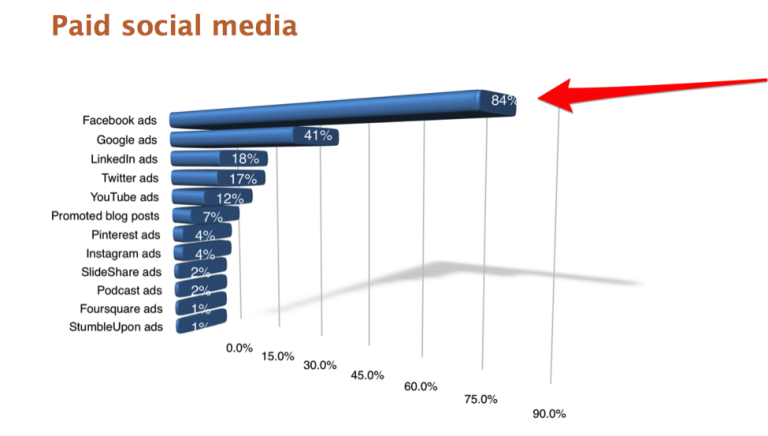
And according to AdWeek, we spend around 28% of our time online on social networking:
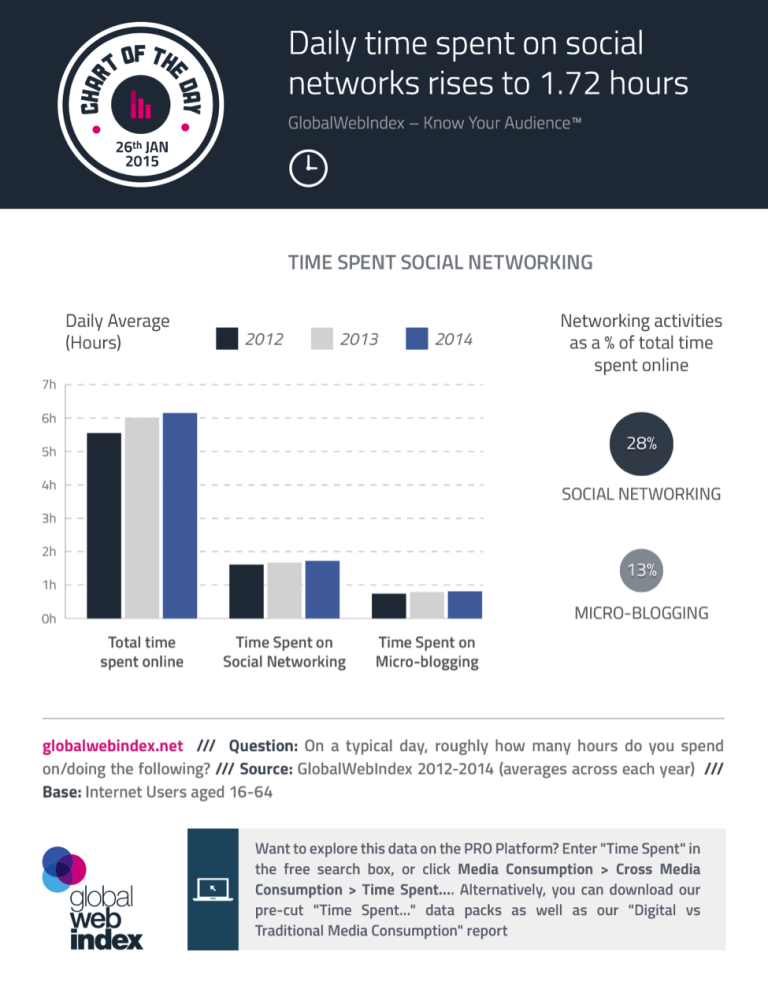
Statista reports that consuming content is one of the primary activities on Facebook:

Facebook also attracts both B2C and B2B audience, making it a viable promotion channel for practically any business.
So regardless of whether you target customers or brands, you have a big chance of attracting them to your content.
Facebook offers many opportunities to promote content via its Advertising Platform, and Page Post Link ads can help you drive more traffic to your content. These ads typically show in the Newsfeed (also on mobile) and clicking on this ad takes a user directly to a website.

Page Post Link ads include a big image which makes it perfect to help catch your ADHD-prone audience’s attention. What’s more, Facebook allows you to A/B test all elements of the ad to come up with the most converting creative.
Learn More: Facebook Lead Ads: Everything You Need to Know to Increase Mobile Conversions
When setting up your ad, you can target users by:
You can also display your ad to current customers or subscribers by including them in a Custom Audience based on e-mails, phone numbers or Facebook user IDs.
Lastly, you can also use Lookalike Audiences to target people similar to your clients, leads or fans.
Facebook Advertising is a bidding platform, meaning that you can specify how much you’re willing to pay for a campaign.
On Facebook, you can bid on Cost Per Click, Impressions, Cost Per Action/Conversion and Cost Per Like, and the final price is affected by:
I know, it makes no sense at all, does it?
AdWords is an ideal platform to attract new customers or leads, but not to promote content, right? And yet…
The aforementioned Social Media Examiner report states that 41% of social marketers use AdWords to promote content regularly, making it the second most popular paid content promotion strategy.
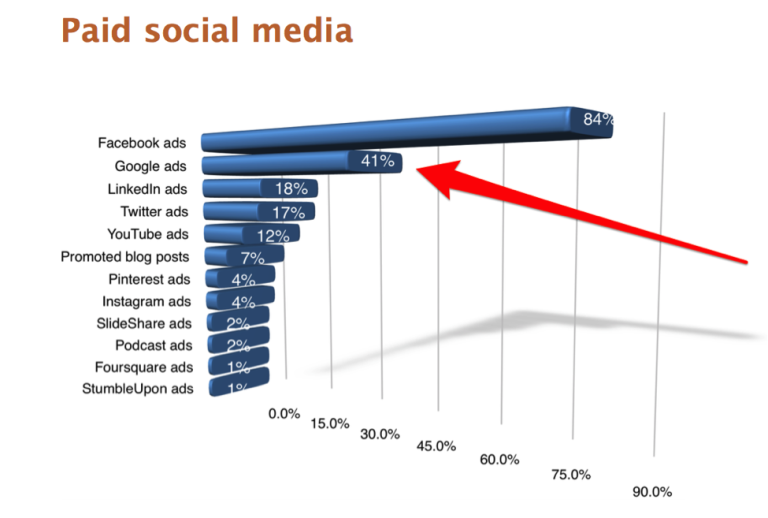
And according to the latest Content Marketing Institute B2B Content Marketing Benchmarks report, search engine marketing is the most popular paid content strategy among marketers.
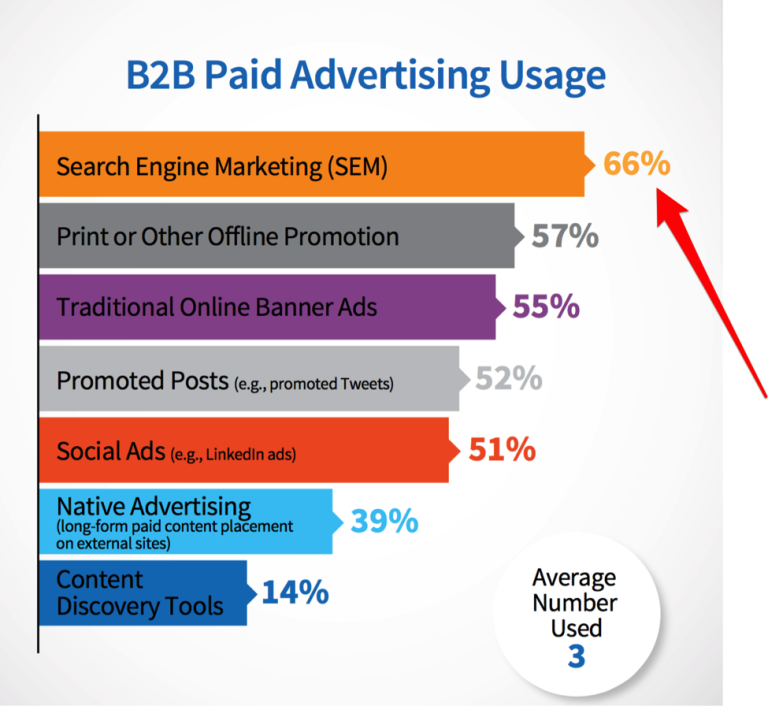
Of the survey participants, 66% admitted to using the Google’s advertising platform to promote their content.
What’s more, 55% consider AdWords the most effective paid promotion strategy.
How is that possible?
You see, AdWords is a versatile yet extremely simple platform to use. Creating an ad takes no more than a couple of minutes, and Google starts displaying it to anyone looking for keywords that you specified practically right away.
Also, the AdWords platform offers extensive research tools which allows you to really make sure that your content reaches the right audience at the right time.
And finally, data you collect in AdWords lets you improve your audience targeting and create much better content in the future.
Google AdWords targets keywords that people actually use to search for information. So when you choose words or phrases that are relevant to your content, your ads appear to those people.
On top of that, you can also target users by location, language, and device they’re using. Also, by using remarketing, you can target people who have visited your site before.

(Example of an AdWords ad promoting content.)
AdWords is an auction-based system in which you specify how much you’re willing to pay for each click on your ad for a specific keyword.
Social Media Examiner reports that LinkedIn is the 3rd most popular paid content promotion strategy among marketers, with 18% of them effectively using it to distribute content.
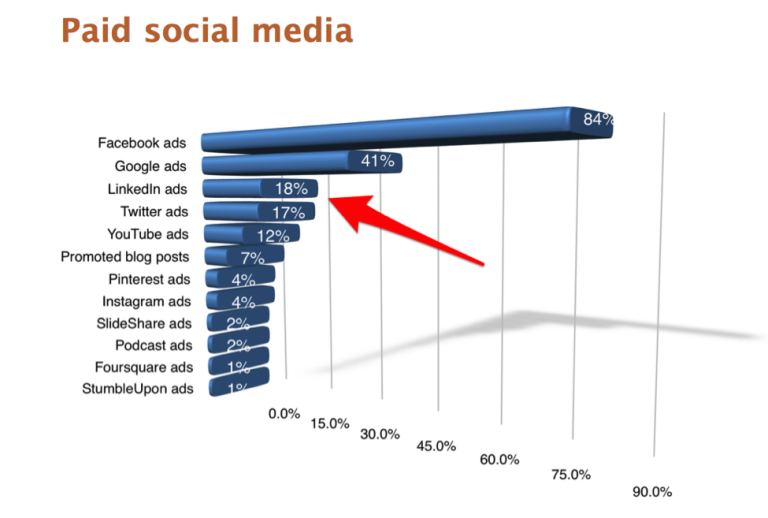
And InsideView states that LinkedIn delivers more leads to B2B companies than any other social networking site or a company’s blog.
LinkedIn offers 3 options to promote your content:
1. Sponsored Updates – a native advertising model in which you display content as a sponsored update in a person’s news feed.
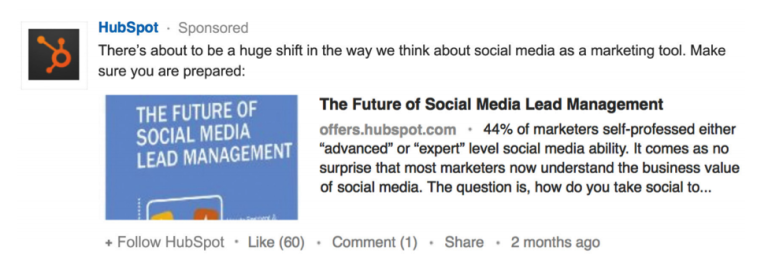
2. Text and Image Ads – allows you to place ads in prominent places across LinkedIn’s website.
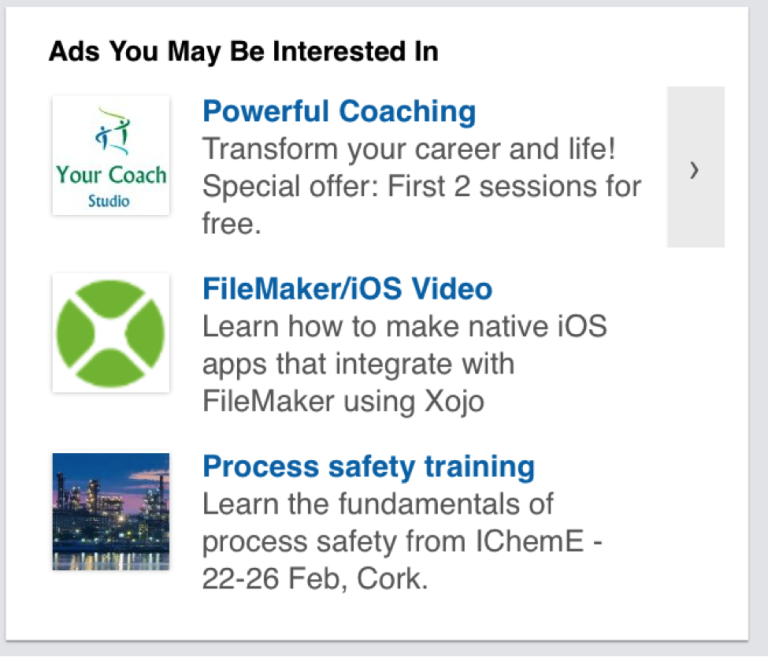 3. Sponsored InMail – lets you use LinkedIn InMail to message targeted audience segments about your content.
3. Sponsored InMail – lets you use LinkedIn InMail to message targeted audience segments about your content.
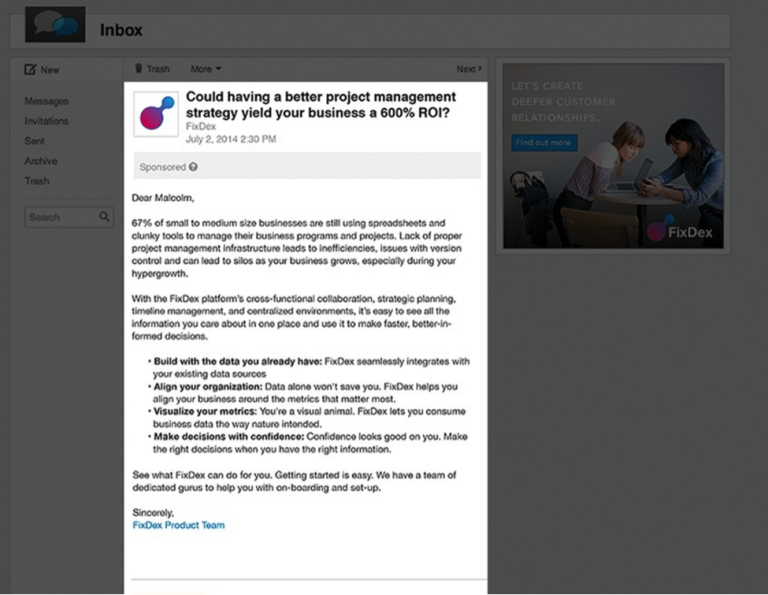
The power of LinkedIn ads lies in their ability to target people not just by their demographics (age, gender, location, etc.), but also by such factors as a job title, employer, industry, company name, company size, skills, LinkedIn Groups they’re members of, and even interests.
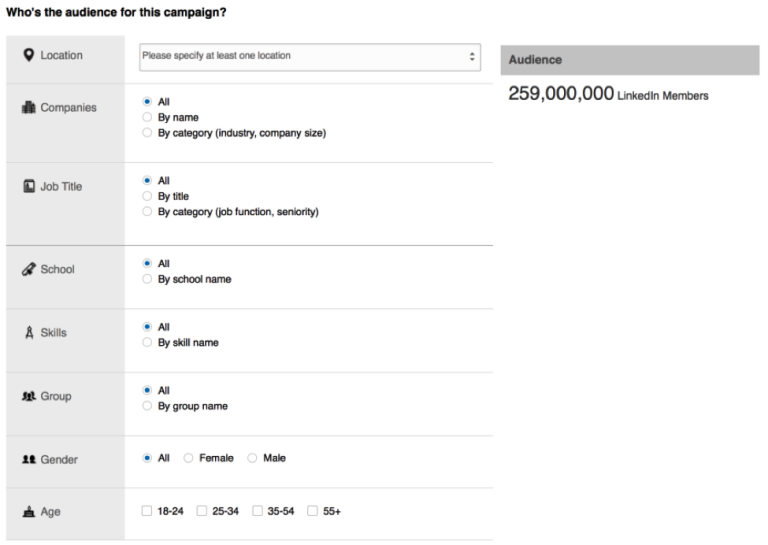
LinkedIn offers two basic pricing models:
I agree: You rarely think of Twitter as a paid content promotion platform.
After all, you already use it to promote your content for free (by sharing every article you write on this platform), and you probably use software like CoSchedule or Buffer to tweet about archived content.
You might even reach out to influencers to help you spread the word on your posts.
But I bet you never considered paying to promote your content on Twitter.
Consider this:
Twitter Ads offers an option to publish Promoted Tweets that are nothing but ads disguised as tweets that appear in a person’s timeline. In most cases, the only difference between normal and promoted tweets is a little “Promoted” label in the bottom left corner.
Learn More: Do Twitter Ads Really Work? (And How to Get The Most Out of Them!)
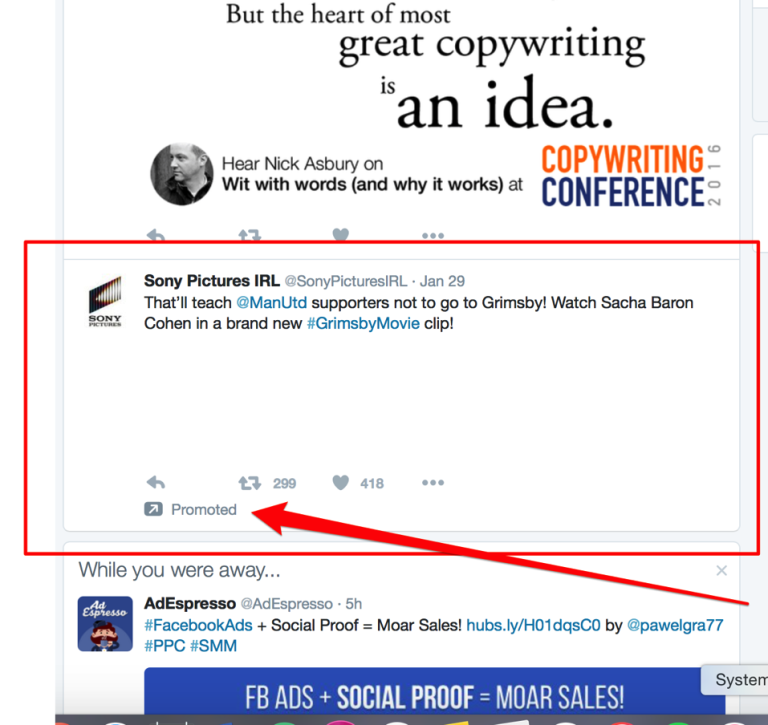
Twitter offers advanced targeting options to ensure that your content reaches a highly-qualified audience.
For example: on Twitter, you can target users based on their interests, accounts they follow or keywords and user behavior.
Like most platforms I discuss in this post, Twitter Ads is an auction based system.
However, unlike AdWords, for instance, on Twitter you’re not bidding on keywords but rather specific actions that you want the person to complete.
You can choose from such actions as clicks, acquire new followers, engagement, app installs, leads or video views.
I bet this happens to you all the time: You discover an interesting article, and just when you get to the end of it, you notice a link to another one.
And then another one.
And another one….
And before you know it, you’ve spent an hour consuming countless pieces of content.
The next platform I’m discussing here makes it possible to promote content by targeting this very behavior.
Outbrain is a service that allows you to target that very behavior and promote your post on other pieces of content in order to attract readers from other websites.
The platform displays a widget with a list of recommended articles below every post on the sites that use it. Here’s a screenshot showing the widget in an article in the Time Magazine:
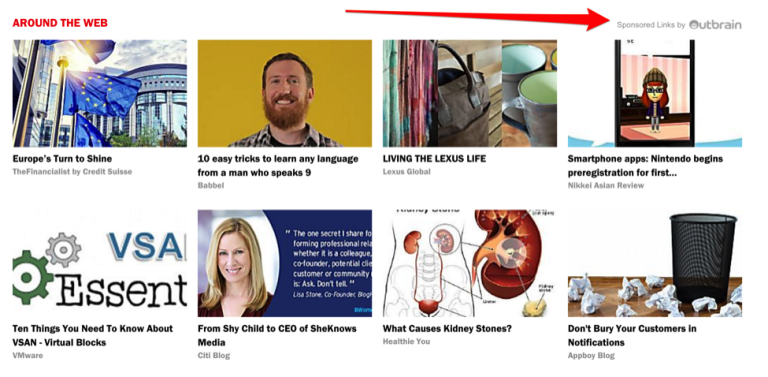
Just like the other paid content promotion platforms, Outbrain works on a Cost Per Click basis, meaning that you pay only for the visitors who go to the page that you’re promoting.
Note: Outbrain is just one of many content discovery networks. Other, similar platforms include:
Fact: Reddit is the front page of the web.
Just last month alone, the site received 231,625,384 unique visitors (subject to change, as you can see), viewing 8,194,956,819 pages and casting 29,170,122 votes.
Impressive, huh?
What’s more, the site offers incredible opportunities to promote your content.
Reddit is made up of “subreddits”, which are categories that users create to discuss related topics. You can submit content directly to a relevant subreddit or use Reddit Ads to ensure that a specific audience will notice it.
Reddit allows you to target users by their interests, specific subreddit they subscribe to, location, or display your ad to all of Reddit, without any particular targeting.
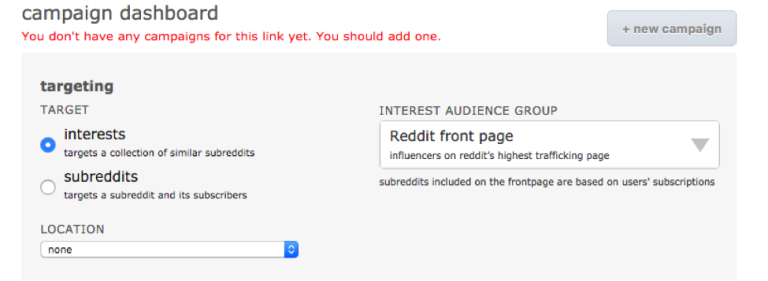
Reddit charges for impressions (CPM), which means that you pay a flat fee for every 1,000 ad impressions.
Here are the rates as per Reddit’s FAQ page:
I agree: It probably wouldn’t make sense to use banner ads to promote every piece of content.
But if you’ve published a report, long-form guide, e-book or other lead magnet, banners might be a way to attract a new audience to them.
BuySellAds is a platform that connects publishers with publishers and allows them to buy and place banner ads on the sites.
On BuySellAds, you can purchase banner ad space, publish sponsored content, and buy individual ad spaces on thousands of sites.

BuySellAds organizes publishers by categories and topics, so you can find websites with the audience you’re trying to reach:
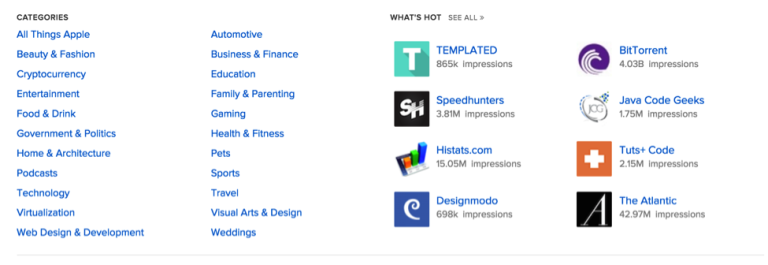
Along with the basic information about the site, BSA also displays the most recent audience stats like monthly impressions and Twitter following:

Information about ad placements and types is available on the site along with prices:
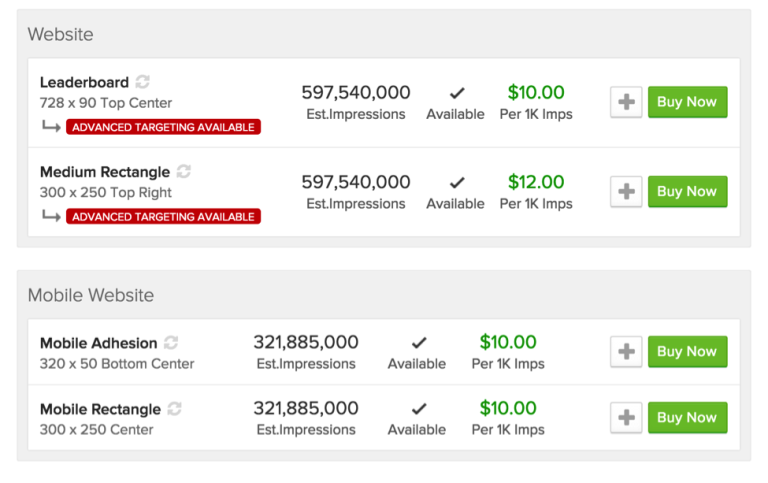
Price per ad placement is determined by each site and can range from as little as $10 and as much as hundreds of dollars, depending on the site’s popularity and audience engagement.
With so much new content published every day, getting your target audience to notice your content is one heck of a task. One way to achieve this goal is to always promote it via owned and earned media.
Or you could use paid ads to attract more targeted visitors to your site.
Now that you understand what the different paid content promotion platforms are and the pros and cons of each one, you’ll have a much easier time getting potential prospects to notice your content!
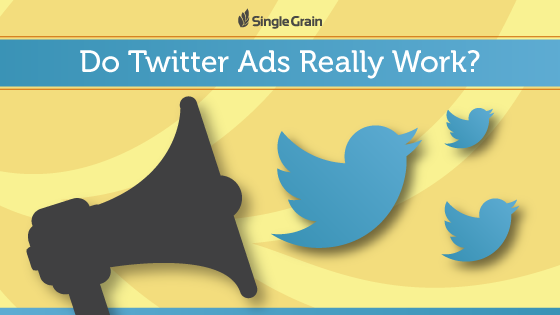
This post originally appeared on Single Grain, a growth marketing agency focused on scaling customer acquisition, by Peter Boyle.
The marketing world can be pretty confusing, right?
We all want the best results, but it’s hard to know whether you should focus on the current model of content marketing, e-mail campaigns (the king of ROI), or the social crowd (Twitter, Facebook, and other social media networks).
The list goes on and on. Every year new marketing methods spring up and with them a new set of gurus who vehemently defend that particular approach as the best thing for taking your business to the next level.
Rest easy, I’m no guru and I’m not going to push a new marketing method with some terribly hyperbolic sales pitch on you. What I am going to do is examine one of the more popular marketing approaches that has not only outlived many fads, but has adapted to the times.
I am, of course, referring to paid advertising.
The act of paying a third party with better visibility or larger distribution to promote your business is as old as marketing itself. But one of the reasons paid advertising has remained so popular is that it’s managed to adapt with the times.
Technological developments have enabled marketers to set up and implement a campaign in next to no time, and the data that’s available from these campaigns makes getting the most out of your campaigns easier than ever before.
One of the more recent developments, and the one I’d like to focus on in this piece, is how paid advertising has crossed over into the world of social media.
Large numbers of people use social media in their day-to-day lives. Facebook, Twitter, LinkedIn, and other networks each attract anywhere from hundreds of millions to billions of monthly users. With such a huge user base, social media is the ideal platform for you to increase the reach and visibility of your business.
While all networks share some common features, getting the most out of each with a paid campaign is an entirely unique effort. This article is going to focus on how to get the most out of your Twitter paid ad campaign.
Read More: The Complete Guide to Gmail Ads (How We Got $.10 CPCs & Leads As Low As $7)
I know what you’re thinking.
Paid ads are great and all, but is Twitter really the best option? I mean, if you’re set on a paid social media ad campaign why not go with the big fella—Facebook?
I can’t argue that the reach Facebook offers is greater, quite a lot greater in fact!
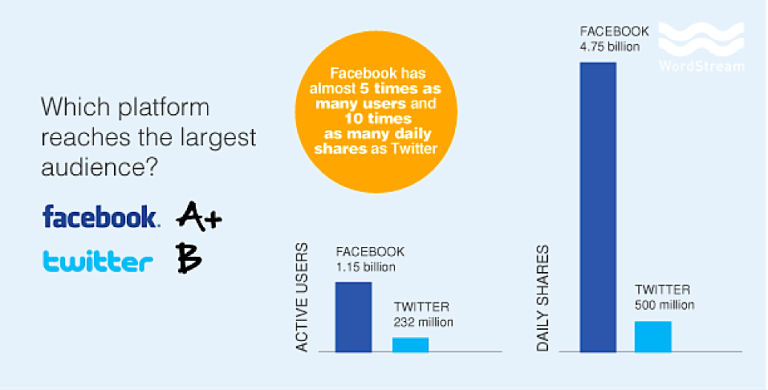
But as folks are given to saying: size isn’t everything. Yes Facebook might be bigger, but Twitter has a few little gems that make it a pretty worthwhile contender for your attention.
What really makes Twitter worthwhile is its effectiveness.
Call me old fashioned, but if I’m running a paid campaign, I’m most interested in the financial side of things. I want to know how much it’s going to cost and how great the ROI is. As such, I’ll track:
You might notice how I’ve completely omitted a few favorites.
As far as I’m concerned, CTR, impressions or any of the other favored metrics don’t affect your bottom line and as a result shouldn’t be your focus. They’re still important and will play an important role in optimizing your campaigns, but your primary focus should always be on how it affects the company’s bottom line.
And it’s here that Twitter excels.
A couple years ago there were a number of studies conducted on the effectiveness of paid advertising on different networks. Below are the results for lead gen from Optify.
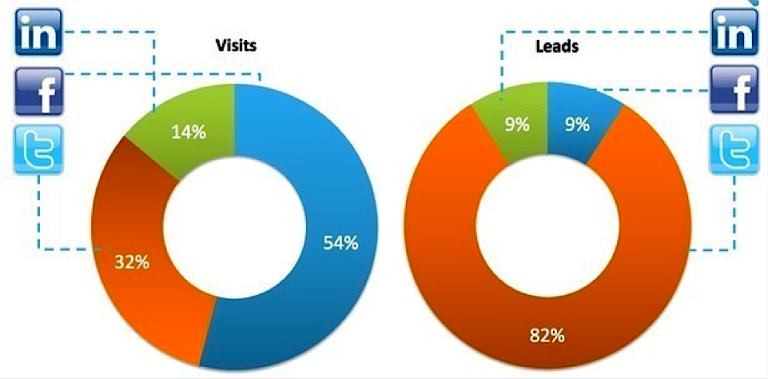
Studies also point to Twitter dominating the mobile space. A pretty big deal considering that 2015 saw the first instance of mobile browsers exceeding their desktop counterparts.
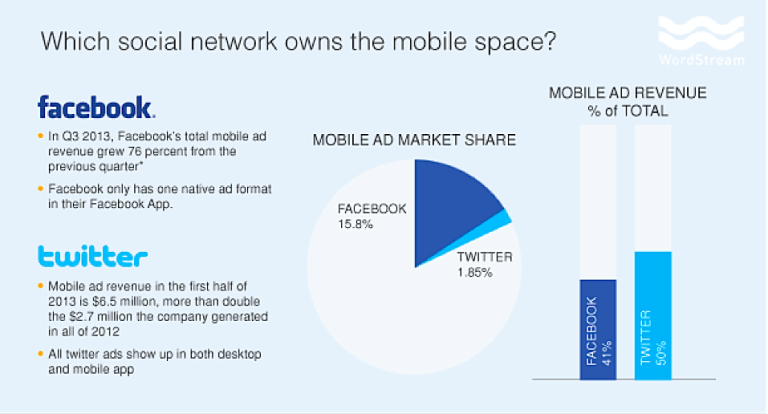
But this was a few years ago; surely the faster growth of Facebook has skewed these results and left Twitter in the dust, right?
Not according to this study by Yotpo, which found that Twitter still has a higher conversion rate and average order value.
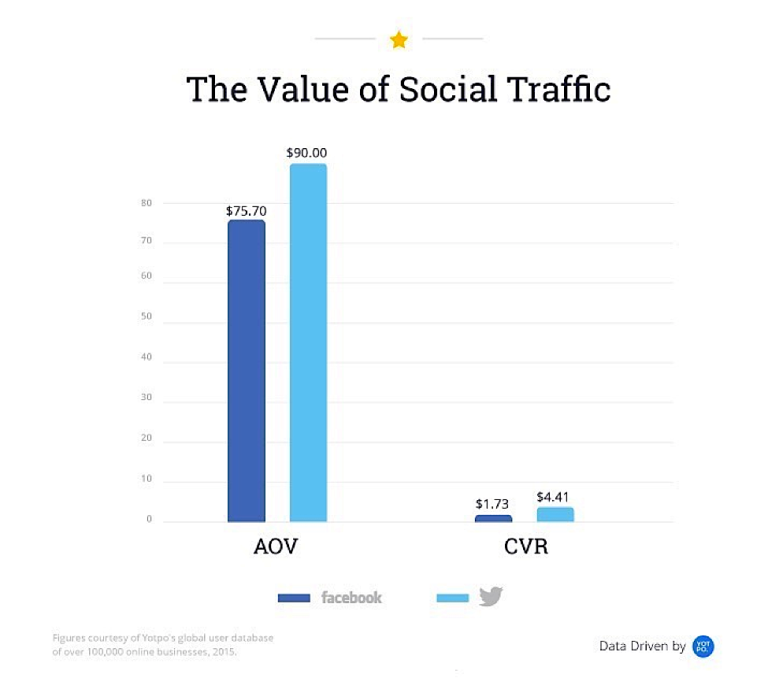
Twitter may well be smaller and have a more limited reach than Facebook, but that hasn’t stopped it from pulling ahead in the metric that counts: conversions.
The question, then, is how to ensure that you’re seeing the greatest conversion and revenue gains with your Twitter ads.
What do you want to achieve with your Twitter advertising campaign?
That should be the first question you ask yourself. Admittedly it’s pretty broad and can encompass a lot. Thankfully, Twitter’s selection of campaigns should help you decide on what next steps are best for your needs.
Upon logging into the Ads dashboard you’ll be greeted with the below:

Here’s how each campaign breaks down.
Followers
As you’d expect, this campaign is aimed at increasing your Twitter following. The cost for the campaign works on a cost-for-follow basis, meaning that you only pay when you gain a new follower.
The ads appear in two different formats depending on whether you include a tweet or not. Those who don’t will have an ad that looks like this:
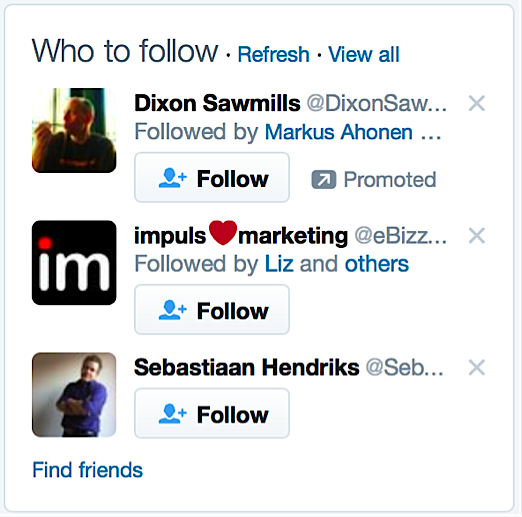
And those that do will have an ad that looks like this:
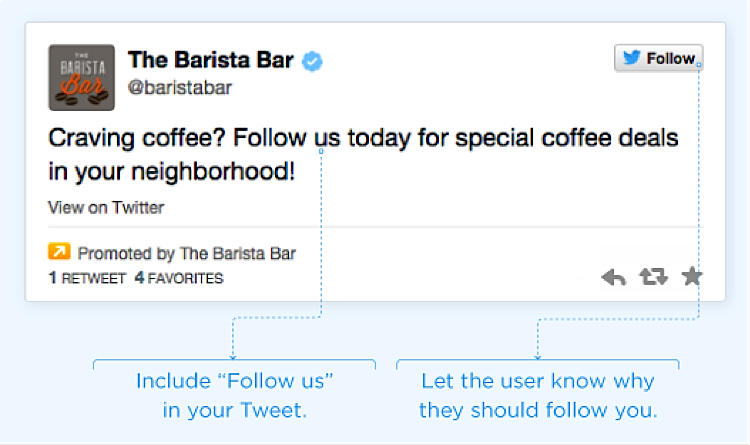
This is a great option for new businesses on Twitter but it’s not really the best option for an established brand. If you’ve been around a while, there are plenty of other smart tactics I’d recommend over paying for new followers.
Web clicks or conversions
This is one of the best options for those looking for quick traffic or conversions. The parameters you set when establishing the campaign define the audience that will see these tweets. The tweets you create are accompanied by a ‘learn more’ button which redirects them to your website or landing page.
Read More: LeadPages CEO Clay Collins Talks About How To Ramp Up Your Conversion Rates – Up To 75%! (podcast)
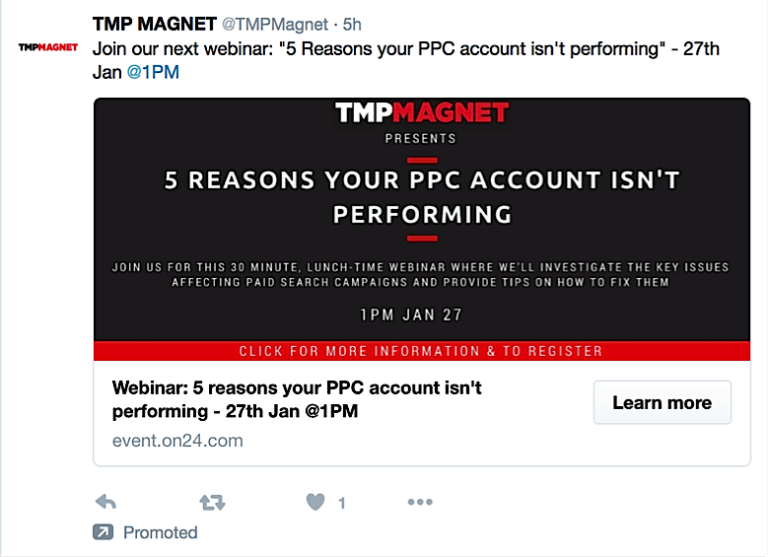
Tweet engagements
This is one of those options that’s really only useful if you’re looking for an incredibly engaged audience. It’s not a bad campaign by any means, but it’s not necessarily going to have the same impact on your bottom line.
Aside from the obvious benefits of increasing reach and visibility, this campaign can be a goldmine for marketers doing a little audience research.
Ask a question to which you need to know the answer so that you can optimize your marketing and promote it. More people will see it and, on top of the retweets and favorites, you’ll get some great answers to help hone your approach.
App installs or re-engagements
Got an app? Want more people to use it? Then this is the campaign for you.
This campaign puts a direct install link on your tweets so the prospects you’re targeting can quickly and easily install the app at the touch of a finger.
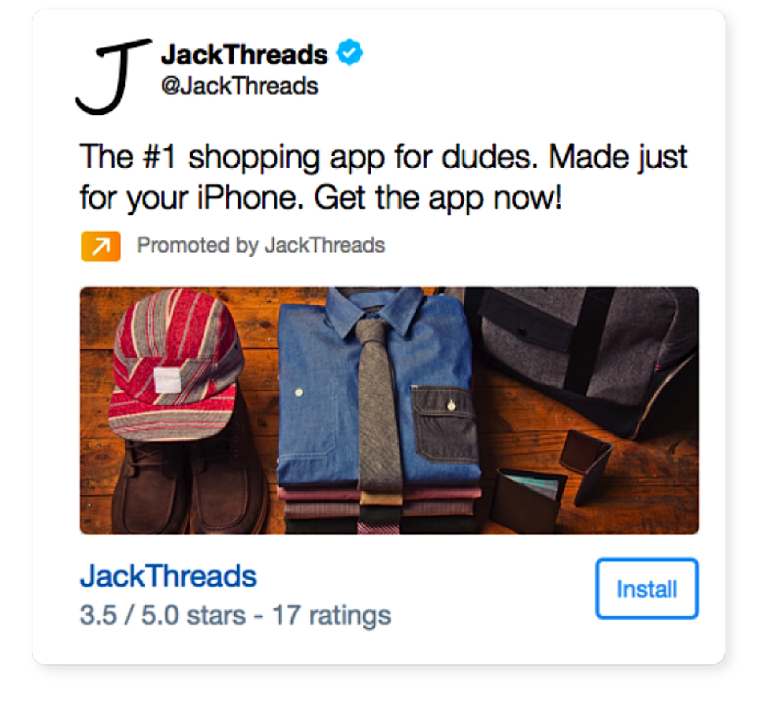
The great thing about these ads is that you’re not going to waste money through dumb folks on desktop computers clicking the install button. These ads are only displayed to Twitter users on mobile.
Leads on Twitter
Twitter offers an easy sign-up procedure that integrates with many of the popular e-mail marketing services. You’re able to include a lead generation card in your ad which then adds the prospect directly to your list.
These are great. They not only contribute to a meaningful metric (the money’s in the list, right?), but they abolish the need to fill out a form. With these, your prospects literally just click a button.
Video views
This is a relatively new feature.
Twitter will promote your videos to targeted customers. What’s key to note here is how they charge. According to their info page, they consider “a chargeable view as 3 seconds of playback in 100% view in the timeline, or a click to watch in fullscreen/unmute — whichever comes first.”
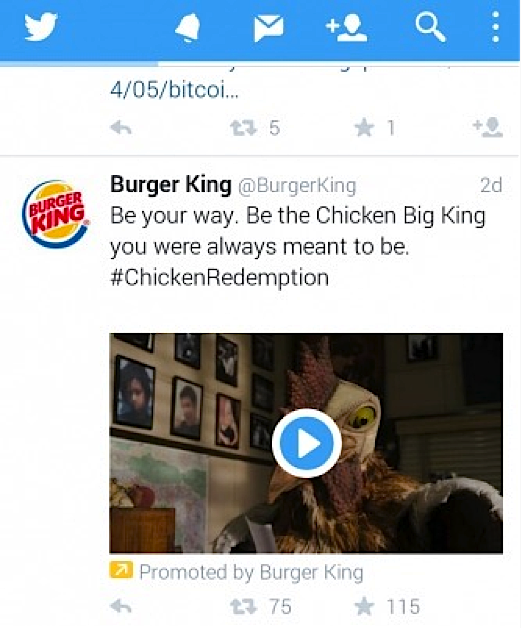
Of course, video is well known as being an incredibly engaging and successful form of content. However, you’ll need to keep an eye on whether that three-second rule is ruining your campaign budget.
Remember, this campaign is costing you cash. You’re going to want every click you pay for to have the best possible chance of converting into a paying customer.
The biggest mistake marketers make with PPC campaigns is going on gut instinct. You might know your product better than anyone else and you may well have some pretty kickass audience personae mapped out, but that doesn’t mean that you can implement your targeting without doing a little research first.
The targeting parameters with Twitter Ads aren’t going to present anything you haven’t seen before.
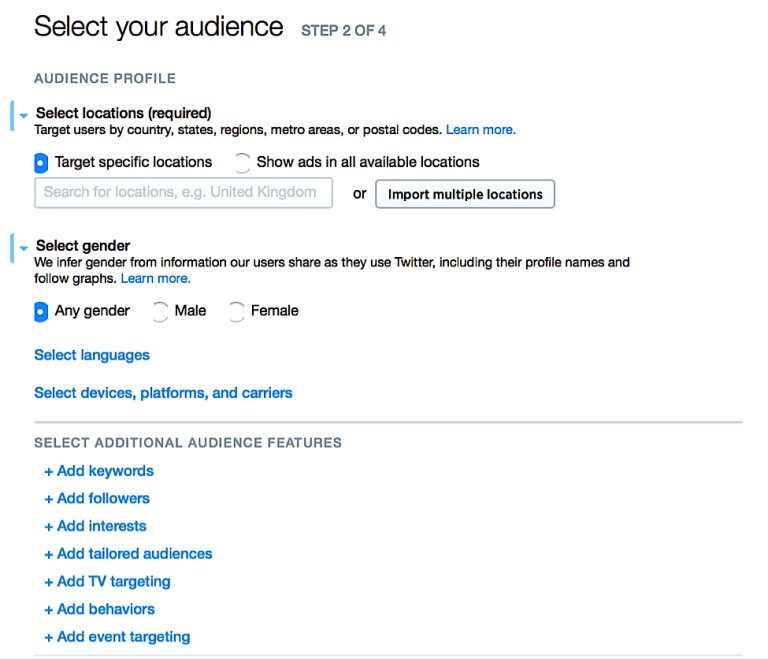
The only things that may surprise veteran marketers are the specificity of the locations (seriously, you can target specific postal codes which is great for local businesses!) and perhaps the option to target by TV show preference.
The rest are pretty run of the mill so I’m not going to waste time with a redundant explanation of what location is or how to target followers of larger related accounts.
Instead I want to quickly touch on how to get your campaign off to the best start. Not by targeting those you think might be interested in whatever it is you’re offering, but by using the data of those who have already converted.
Your Google Analytics account has a wealth of information to get your campaign off to the right start. to begin with, you can pull interest data straight from GA as is. Organize this data from highest-converting interest category to lowest and you’ll have a great starting point for your interest-targeting Twitter Ads.
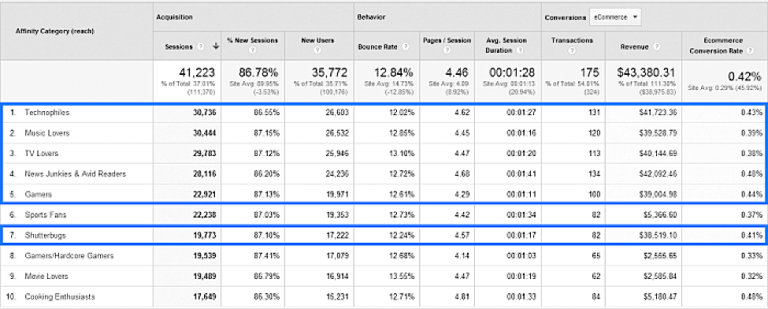
You can do exactly the same to pull pertinent information for other key demographic information.
After you’ve done this you’ll want to find the keywords that convert on GA. You should already have tracking set up on GA so you know the exact behavior of those who convert and the revenue they bring.
The next thing to do is implement this custom report created by Griffin Roer over on KISSmetrics. The report will show you your landing pages organized by organic searches. Again, filter this by conversion rate to know which landing pages have the highest conversion rate.

Make a note of the top-converting landing pages before heading over to Webmaster Tools. Open Search Traffic > Search Analytics and use the filter option on pages to find the highest-converting pages outlined in the above GA report.
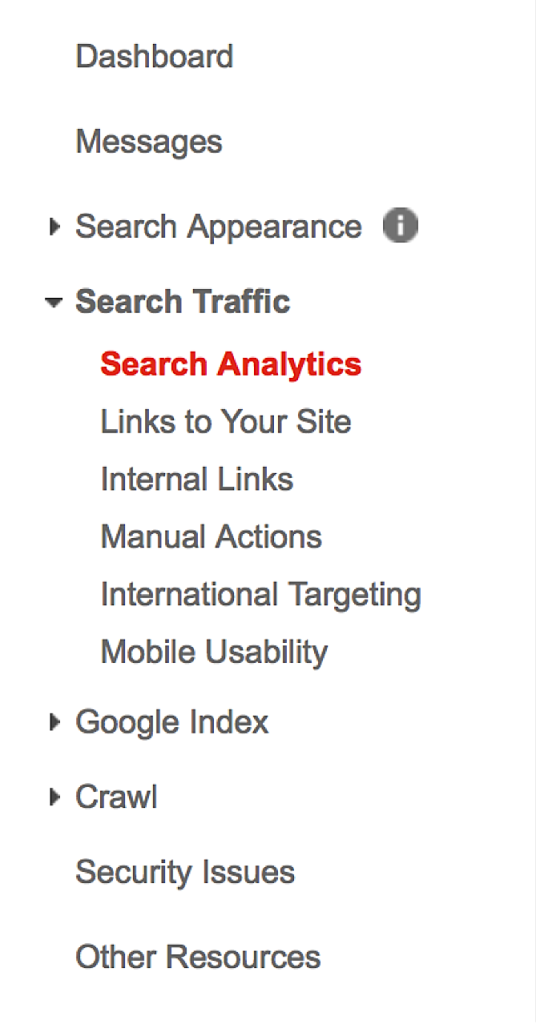
Once you’ve filtered by your top-converting pages, click on “Queries.” This will bring up a great list of the terms that garner the highest number of clicks on Google.

These terms, while from organic results, obviously appeal to the segment of your audience that converts, so they’d be a good starting point for you in your targeting.
Once you’ve done the whole GA thing, you’ll want to supplement and cross reference the information with the engagement rates that your Twitter account is already receiving.
Your next stop is over on Twitter’s Analytics suite.
There are lots of visually impressive results in Twitter’s Analytics dashboard, but more often than not they’re just a visual representation of your audience. I’m not aware of any way to track conversions unless you’ve already set up Twitter’s conversion tracking. Something that very few people I’ve spoken to seem to have done.
Read More: 13 Quick Tricks to Increase Conversion Rates that You Can Do Right Now
However, you can track which of your tweets gained the highest engagements by clicking on the “Tweets” heading in the menu.

Ignore the pretty graph at the top of the page, scroll down, and click on “Top Tweets” and you’ll find a list of your tweets with the highest engagement rate.
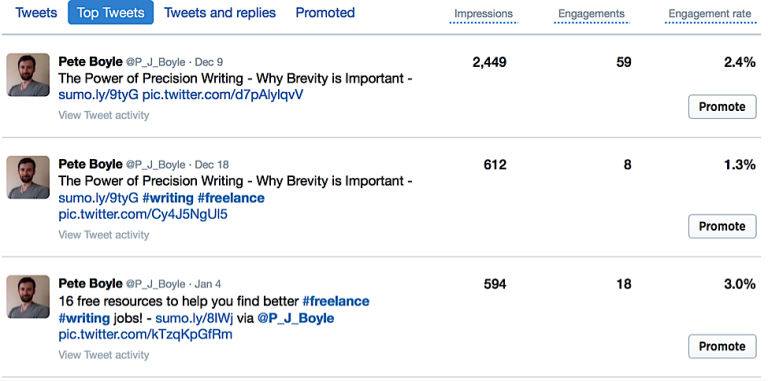
Copy the text from your top tweets and cross reference them with your GA data. Doing so should help you understand the kind of copy that resonates well with your audience.
If there’s a keyword or phrase that pops up across both platforms regularly, it’s likely that it’s going to grab attention and convert those users into list subs or paying customers. Use it in your keyword targeting and in your Tweet copy.
Over 80% of Twitter users access the platform through mobile. If you’re redirecting users to a landing page on your site, make sure it’s optimized for the device and OS they’re using.
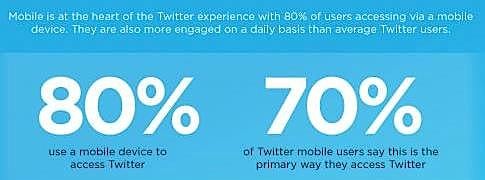
There’s nothing worse when on mobile than clicking a link and finding yourself on a page optimized for desktop. Links are too small to click with a finger, copy gets cut off by the smaller display, and the whole process just seems to run sluggishly.
These little annoyances are enough to put anyone off converting. Target your ads to appear only to those on mobile or desktop, but ensure that the links within those Tweets link to pages that are optimized for that audience.
You’ll also want to target ads and have specific landing pages for:
It seems like overkill, but the best way to ensure a higher rate of conversion is to provide an ultra specific and tailored experience.
You’ve got to ensure that the page you’re directing people to is perfectly optimized for their needs and behaviors.
Twitter often seems to get overlooked simply because it doesn’t have the reach of Facebook. But studies clearly show that it’s an incredibly effective platform for gaining a higher level of conversions.
Implementing any form of paid marketing strategy shouldn’t be done without thorough planning. Before you pay for your campaign to go live make sure that you’re not only comfortable with the way Twitter Ads works, but also feel confident that you know exactly who you’re targeting.
Have you used any other methods to help better target your Twitter campaign? Leave a comment below and let us know!
How Content Marketing as a Growth Channel Propelled BuildFire into a 7-Figure ARR SaaS Company

Hi everyone, today we have Ian Blair who is the CEO of BuildFire, which provides the easiest way to build mobile apps in under five minutes. It’s a no-coding-required app-building platform where people can quickly build their own mobile apps and it works in any industry because every brand can benefit from an app.
Today we’re chatting about how BuildFire grew to a seven-figure ARR by using content marketing rather than paid advertising, the main factors that got them there in the very competitive SaaS industry, the reason keyword research is essential, and why you must have a methodology for creating and tracking your content’s progress and success.
Download podcast transcript [PDF] here: How Content Marketing as a Growth Channel Propelled BuildFire into a 7-Figure ARR SaaS Company TRANSCRIPT
Episode highlights:
Resources from this interview:
Leave some feedback:
Connect with Eric Siu:
How Drip Club Used Influencer Marketing to Get 250,000 Instagram Followers and Grow the Business 1,000% in One Year

Hey everyone, today we have a very special show featuring three of my friends from high school: Andrew Tsai, Jonathan Hong, and Mike Zhang, co-founders of The Drip Club, a trusted online e-liquid and vape shop. Andrew is the VP of Sales, Mike is the CEO and Jonathan is the VP of Products.
On today’s show we’ll be talking about how The Drip Club began as an online subscription service, similar to BirchBox, and evolved into a consumer products company, what they did to get to a quarter million Instagram followers without paid advertising (which they can’t do because of the industry they’re in), and how they scaled the effectiveness of working as a team with a divide-and-conquer strategy.
Download podcast transcript [PDF] here: How Drip Club Used Influencer Marketing to Get 250,000 Instagram Followers and Grow the Business 1,000% in One Year TRANSCRIPT
Episode highlights:
Resources from this interview:
Leave some feedback:
Connect with Eric Siu:
Enter your email to get free instant access
Notifications